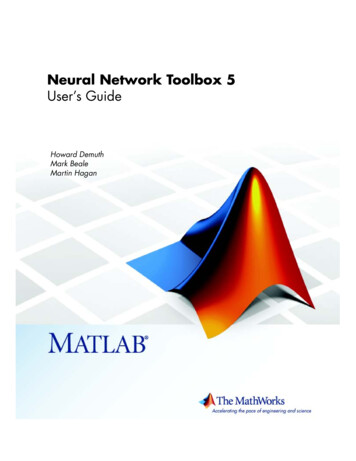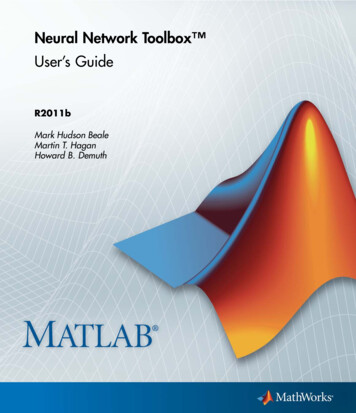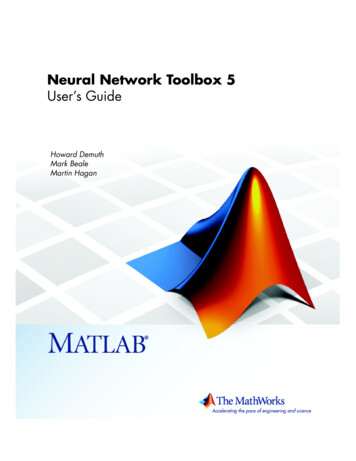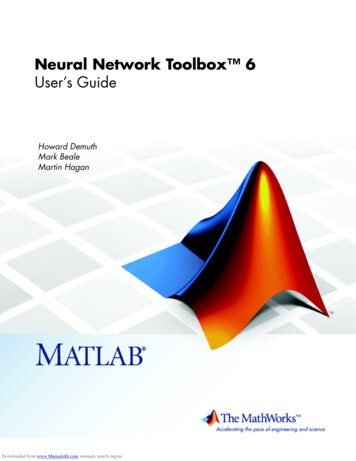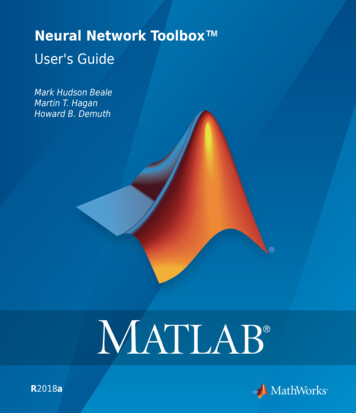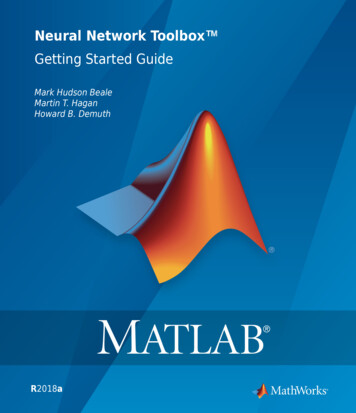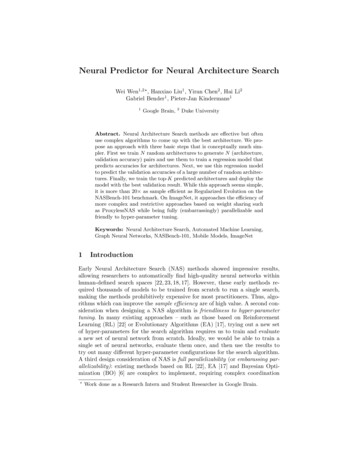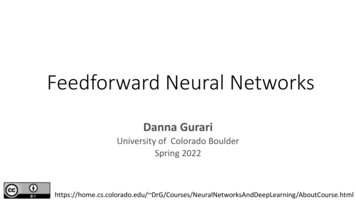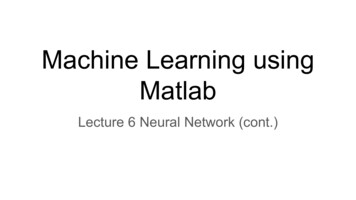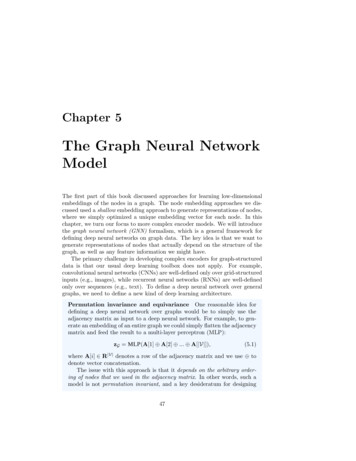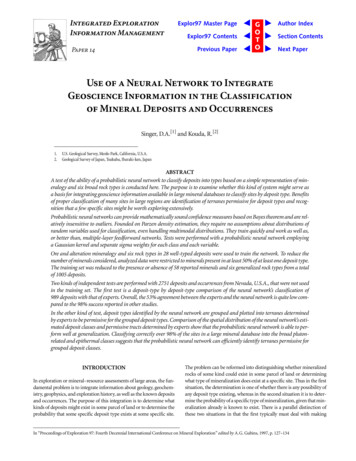
Transcription
Integrated ExplorationInformation ManagementExplor97 Master PageExplor97 ContentsPrevious PaperPaper 14GOTOAuthor IndexSection ContentsNext PaperUse of a Neural Network to IntegrateGeoscience Information in the Classificationof Mineral Deposits and OccurrencesSinger, D.A.[1] and Kouda, R.[2]1.2.U.S. Geological Survey, Menlo Park, California, U.S.A.Geological Survey of Japan, Tsukuba, Ibaraki-ken, JapanABSTRACTA test of the ability of a probabilistic neural network to classify deposits into types based on a simple representation of mineralogy and six broad rock types is conducted here. The purpose is to examine whether this kind of system might serve asa basis for integrating geoscience information available in large mineral databases to classify sites by deposit type. Benefitsof proper classification of many sites in large regions are identification of terranes permissive for deposit types and recognition that a few specific sites might be worth exploring extensively.Probabilistic neural networks can provide mathematically sound confidence measures based on Bayes theorem and are relatively insensitive to outliers. Founded on Parzen density estimation, they require no assumptions about distributions ofrandom variables used for classification, even handling multimodal distributions. They train quickly and work as well as,or better than, multiple-layer feedforward networks. Tests were performed with a probabilistic neural network employinga Gaussian kernel and separate sigma weights for each class and each variable.Ore and alteration mineralogy and six rock types in 28 well-typed deposits were used to train the network. To reduce thenumber of minerals considered, analyzed data were restricted to minerals present in at least 50% of at least one deposit type.The training set was reduced to the presence or absence of 58 reported minerals and six generalized rock types from a totalof 1005 deposits.Two kinds of independent tests are performed with 2751 deposits and occurrences from Nevada, U.S.A., that were not usedin the training set. The first test is a deposit-type by deposit-type comparison of the neural network’s classification of989 deposits with that of experts. Overall, the 53% agreement between the experts and the neural network is quite low compared to the 98% success reported in other studies.In the other kind of test, deposit types identified by the neural network are grouped and plotted into terranes determinedby experts to be permissive for the grouped deposit types. Comparison of the spatial distribution of the neural network’s estimated deposit classes and permissive tracts determined by experts show that the probabilistic neural network is able to perform well at generalization. Classifying correctly over 98% of the sites in a large mineral database into the broad plutonrelated and epithermal classes suggests that the probabilistic neural network can efficiently identify terranes permissive forgrouped deposit classes.INTRODUCTIONIn exploration or mineral–resource assessments of large areas, the fundamental problem is to integrate information about geology, geochemistry, geophysics, and exploration history, as well as the known depositsand occurrences. The purpose of this integration is to determine whatkinds of deposits might exist in some parcel of land or to determine theprobability that some specific deposit type exists at some specific site.The problem can be reformed into distinguishing whether mineralizedrocks of some kind could exist in some parcel of land or determiningwhat type of mineralization does exist at a specific site. Thus in the firstsituation, the determination is one of whether there is any possibility ofany deposit type existing, whereas in the second situation it is to determine the probability of a specific type of mineralization, given that mineralization already is known to exist. There is a parallel distinction ofthese two situations in that the first typically must deal with makingIn “Proceedings of Exploration 97: Fourth Decennial International Conference on Mineral Exploration” edited by A.G. Gubins, 1997, p. 127–134
128Integrated Exploration Information ManagementTable 1:Minerals used in the training and validation olucite/ wadSb oxidesestimates for polygons whereas in the second, the estimates are typicallyfor a specific site. Knowing the kinds of mineralization at discoveredmineral occurrences provides information about the specific sites considered and about the types of mineralization possible in the broadergeologic setting of the occurrences. Knowledge of deposit types wouldbenefit exploration in the identification of specific sites of interest andthe possibilities of associated deposit types. In addition, classification ofdeposit types in a region aids in the identification of permissive terranesfor specific and related deposit types.If it were possible to classify correctly a large proportion of depositsand occurrences into deposit types based on the kinds of informationfrequently available in the geologic literature, then perhaps a systemcould be built that would automatically screen large data files. In such asystem, the necessary and sufficient information would exist to discriminate among deposit types. Extensions to this kind of system might serveas a basis for integrating geological, geophysical, and geochemical information for estimating and managing risk. The key issue is how shouldthese diverse kinds of information be combined.Barton (1986) provided estimates of the frequency of mineral occurrence by deposit type. His subjective estimates for over 150 minerals inabout 80 deposit types were used by McCammon (1992) in conjunctionwith subjective estimates of frequencies of rock types, ages, alteration,geophysical and geochemical signatures in an attempt to classify deposits with a system called Prospector II. McCammon’s test of this system(1992) resulted in 83% of 124 Alaskan deposits correctly classed.In expert systems like Prospector II, a human expert’s knowledge, inthe form of qualitative principles as perceived by the expert, is encoded.Performance of these systems depends on the quality of the expert’sknowledge and the care taken in the representation of that knowledge.Such expert systems are desirable where the underlying model relationsor information are not known. Expert systems have difficulties where theexperts are internally inconsistent or rely on inconsistent information.Where information is available, inductive learning systems exist thatcan use pre-classified samples as a training set to learn the appropriateclassification rule. These learning systems can be successful at classifying previously unseen samples, that is, at generalization. Examples ofscheelitesideriteinductive learning systems are decision trees (Quinlan, 1986), artificialneural networks (Masters, 1995), and statistical pattern recognition(Fukunaga, 1990). Features of statistical pattern recognition such asprobabilistic estimates of class membership and ability to handle contradictory examples are integral to probabilistic neural networks.The correct classification of 98% of 267 mineral deposits into eightdeposit types using mineralogy and two rock types by Singer and Kouda(1997) suggested that a probabilistic neural network might do an excellent job of integrating the diverse geoscience information. To test theability of a probabilistic neural network to classify deposits into typesbased on a simple representation of mineralogy and six broad rock typesis conducted here. The nature and sources of data are discussed first.Following this, probabilistic neural networks and their implementationin this study are discussed. Classification of deposits into types by theneural network is tested in the next section with data in a large databasecontaining deposits typed by experts and with a comparison of threeclasses of deposit types to tracts of land delineated by experts as permissive for these types in Nevada. Finally, classification errors are examinedand possible improvements identified.TRAINING DATAInitially, it might appear that geochemical and geophysical data wouldbe ideal for geoscience information integration projects because they areso numerous. However, the probabilistic neural network needs manyexamples from each group to be classed in order to reflect the variabilitywithin each group. It is not clear that the large effort required to find andrecord such geochemical or geophysical information, if it exists for morethan a few deposit types, would be fruitful. A more tractable problem isto try to integrate mineralogy and a few rock types as reported in largemineral databases; this is the approach taken here.Information on the mineralogy of mineral deposits varies widely inquantity and quality. Depending on the purpose of a study and itsresearcher’s interest, a report on a mineral deposit might contain adetailed list of alteration minerals and a mention of unnamed sulphide
Singer, D.A. and Kouda, R.and sulphosalt minerals, a detailed list of ore minerals and mention ofalteration in broad terms, a complete list of all minerals, or a sparse listof minerals. In some studies, the author attempted to list the relative orabsolute amounts of each mineral. Unfortunately, these attempts werenot common and frequently not comparable with many other reportsbecause of different standards. Thus, it was decided to use only the presence or absence of minerals in our study.Both ore and alteration minerals were recorded for this study. Rockforming minerals such as varieties of quartz and feldspars (except adularia) were not recorded, even if they locally represent alteration.General statements about mineralogy such as “clays”, “carbonates”, or“phyllic alteration” present were ignored because multiple mineralswere possible. These decisions were made to keep minerals not related tothe mineral deposit type out of the analysis, to reduce the number ofminerals considered, and to keep the data objective. Even with theserestrictions and the exclusion of clearly single-case listings, the presenceor absence of 155 minerals was recorded. Closely related minerals suchas the tellurides, manganese oxide minerals, anhydrite-gypsum, andenargite-luzonite were combined to further reduce the number of minerals to 119. To further reduce the number of minerals considered, theanalyzed data were restricted to minerals present in at least 50% of atleast one deposit type used in the study. An advantage of this restrictionis that rare occurrences of minerals cannot dominate the results. Thedata were reduced to the presence or absence of 58 reported minerals(Table 1) in 28 deposit types (Table 2). Deposit types are classed basedon the models in U.S. Geological Survey Bulletins 1693 (Cox and Singer,1986), 2004 (Bliss, 1992), and 1811 (Mosier and Page, 1988).Also coded into presence or absence were six rock-type categories.The broad types, marine felsic to intermediate volcanic, marine maficvolcanic, granitoid, subareal felsic to intermediate volcanic, subarealmafic volcanic, and carbonate rocks are intended to capture information about many geologic settings. Rocks not represented would becoded as the absence of all six types. These rock types and the 58 minerals were coded for each of the 28 deposit types (Table 2 ) to train theneural network to recognize the different deposit types. The number ofdeposits available for training varied by deposit type. Some deposittypes, like tungsten veins, only had 12 deposits for training due to thedifficulty of obtaining data. For other types, such as porphyry copper,the authors limited the training to 75 deposits to reduce the size of theproblem for the neural network. Some types varied so little, such as rhyolite-hosted tin, that only 50 deposits were used for training. A total of1005 deposits were used in the training of the neural network.PROBABILISTIC NEURAL NETWORKThe goal here is to be able to make an estimate of the probability that anunknown mineral deposit belongs to a given deposit type. Standard statistical classification methods assume some knowledge of the distribution of the variables used to classify. Typically a multivariate normaldistribution is assumed and the training data are used to estimate themeans and variances. Large deviations from normality or multimodaldistributions cause these methods to fail. Neural networks can typicallyhandle complex distributions. The three-layer feedforward network(Singer and Kouda, 1996) is an excellent classifier (Masters, 1995); however, it trains slowly and does not produce probabilities.NEURAL NETWORKS IN THE CLASSIFICATION OF MINERAL DEPOSITS129Table 2: Deposit types and number of deposits used intraining.Deposit typenumber of depositsBedded barite19Besshi massive sulphide12Cu skarn16Cyprus massive sulphide49Distal disseminated Ag–Au10Epithermal Mn21Epithermal quartz alunite Au–Ag32Epithermal quartz-adularia Au–Ag75Fe skarn50Franciscan Mn50Hot–spring Au–Ag12Hot–spring Hg39Kuroko massive sulphide50Low–sulphide Au–quartz vein75Polymetallic replacement25Polymetallic veins48Porphyry Cu75Porphyry Mo, low–F25Replacement Mn21Rhyolite–hosted Sn50Sediment–hosted Au27Sedimentary exhalative Zn–Pb36Silica–carbonate Hg50Simple Sb50Volcanic–hosted magnetite22W skarn28W veins12Zn-Pb skarn26TOTAL1005Probabilistic neural networks were designed to be classifiers. If weknow the true probability density function, fk(x), for all populations,then there is a Bayes optimal decision rule for classifying unknownsample x into population i:pi ci fi(x) pj cj fj(x)[1]for all populations j not equal to i. Generalizing, pk is the prior probability of the general class k, and ck is the cost associated with misclassification of population k. Under these conditions, a Bayes decision rule willminimize the expected cost of misclassification. The problem is that wedo not know the true probability density function, fk(x). Standardstatistical classification methods, such as discriminant analysis, typically assume that the variables follow a multivariate normal distribution
130Integrated Exploration Information ManagementTable 3: Confusion matrix showing the number of mineral deposits correctly (in bold) and incorrectly classified from thevalidation 12045or that the nearest neighbor is the appropriate class regardless of thedensity of other samples near the unknown.The development by Parzen (1962) of a general way to estimate aunivariate probability density function from a random sample, evenwhen the parent density function is unknown, provides a necessary toolto free us from these constraints. Parzen’s estimator is essentially asphere-of-influence weighting function, frequently termed a kernel, andthe scaling weight, σ, controls the width of the area of influence. Theweighting function has its largest values at sample points and decreasestoward zero as the distance increases.For this study separate weights (σ) were used for each class and eachvariable and a Gaussian kernel was used for the weighting (W) function(Masters, 1995). The choice of the Gaussian function is based on itsexcellent performance and has nothing to do with assumptions of normal distributions. Specht (1990) constructed a neural network form ofParzen’s estimation procedure. In the present study, the algorithms for aprobabilistic neural network developed by Masters (1995) wereemployed. Masters’ algorithms find the scale weights, σ, that 500010102100000230000024000003471Silica-carbonate HgSediment-hosted AuSed. exhalative Zn-PbRhyolite-hosted SnReplacement MnEpith. quartz-alunite Au-AgPorphyry CuPorphyry Mo, low-FPolymetallic veinPolymetallic replacementLow-sulfide Au-qtz. veinKuroko massive sulfideHot-spring Au-AgHot-spring HgFranciscan MnFe skarnEpith. qtz.-adularia Au-Ag0013000000000000010000000001493Epithermal Mn0010000000000000010000000020Distal disseminated Ag-AuCu skarn10000120010007400010000000176Cyprus massive sulfideBesshi massive sulfideBedded bariteBesshi massive sulfideCu skarnCyprus massive sulfideDistal disseminated Ag-AuEpithermal MnEpith. qtz.-adularia Au-AgFe skarnFranciscan MnHot-spring HgHot-spring Au-AgKuroko massive sulfideLow-sulfide Au-qtz. veinPolymetallic replacementPolymetallic veinPorphyry Mo, low-FPorphyry CuEpith. quartz-alunite Au-AgReplacement MnRhyolite-hosted SnSediment-hosted AuSimple SbVolcanic-hosted magnetiteW skarnW veinZn-Pb skarnTotal by networkPercent agreementBedded bariteExpert classExpert classNeural net predicted class0000000000000010000000000010the error of misclassification of the training data using the standard statistical technique called jackknifing in which every case is sequentiallyheld back from training.Probabilistic neural networks require no assumptions about distributions of random variables used to classify; they even can handle multimodal distributions. They train quickly and as well as, or better than,multiple-layer feedforward networks. They have the ability to providemathematically sound confidence levels and are relatively insensitive tooutliers. Mathematically sound Bayesian confidence levels require thatthe classes are mutually exclusive and exhaustive (i.e., no case can possibly fall into more than one population and the training set encompasses all populations fairly). When these conditions exist, Bayes’Theorem can be used to compute the probability that an observation, x,was the member of a population. Each density estimate could be multiplied by prior probabilities and cost constants, if desired. These featuresare not used in this study, however.In many practical situations, the mutually exclusive and exhaustiveclass conditions might not exist. The unknown sample used in testing
Singer, D.A. and Kouda, R.Table 3:NEURAL NETWORKS IN THE CLASSIFICATION OF MINERAL DEPOSITSConfusion matrix (continued).Expert classExpert classBedded bariteBesshi massive sulfideCu skarnCyprus massive sulfideDistal disseminated Ag-AuEpithermal MnEpith. qtz.-adularia Au-AgFe skarnFranciscan MnHot-spring HgHot-spring Au-AgKuroko massive sulfideLow-sulfide Au-qtz. veinPolymetallic replacementPolymetallic veinPorphyry Mo, low-FPorphyry CuEpith. quartz-alunite Au-AgReplacement MnRhyolite-hosted SnSediment-hosted AuSimple SbVolcanic-hosted magnetiteW skarnW veinZn-Pb skarnTotal by networkPercent 22211798953Percent agreementTotal by expertsZn-Pb skarnW veinW skarnVolcanic-hosted magnetiteSimple SbNeural net predicted 761853might be from a population different from any of the training classes.For example, if the mineralogy of a carbonatite deposit were tested in thenetwork developed in this study, Bayesian confidence estimates couldnot be computed properly. The neural network program will estimatethe probabilities that the unknown deposit belongs to the deposit classesit has been taught; thus, careless use of a neural network could lead tomistaken classifications.TESTING THE NEURAL NETWORKBecause of the ability of neural networks to learn the training data well,validation data, not used in any training, is the proper data set to test theefficiency of classification. A data set large enough to test the ability of aprobabilistic neural network to classify many different deposit types isreported in recent papers on Nevada’s resources by Sherlock et al. (1996)and Cox et al. (1996). Approximately 1400 metallic and nonmetallicmineral locations in Nevada were classed into mineral deposit types131(Sherlock et al., 1996) following Cox and Singer (1986). These typedlocations and many untyped mineral sites are available in the MineralResources Data System, which contains over 6100 entries for mineralsites throughout Nevada (Sherlock and Tingley, 1985).After removal of both nonmetallic and duplicate entries, and entrieswithout at least one rock and one of the 58 reduced set of minerals or twoof the 58 minerals, the remaining 2751 sites were prepared for testing intwo different kinds of tests. One kind of test is a deposit-type by deposittype comparison of the neural network’s classification of a set of depositswith that of experts. In the other kind of test, deposit types identified bythe neural network are grouped and plotted into terranes determined byexperts to be permissive for the grouped deposit types and the exceptions are counted.To make the comparison with an expert classification, the neural network was trained to recognize the 28 deposit types in Table 2 using theminerals in Table 1 and the six rock types discussed earlier. Two of thedeposit types used in training, sedimentary exhalative Zn–Pb and silica–carbonate Hg, are not known to exist in Nevada but were added to thetraining set to make the test more realistic. The test data were the MineralResources Data System sites from Nevada that contained at least the minimum number of minerals and that had been classed by Sherlock et al.(1996) into one of the deposit types used in training the neural network.Results of the test on the 989 mineral sites in Nevada that had beenclassed by the experts and had the required minerals in the data file arereported in Table 3. The table can be used to examine how well the neural network agrees with the experts for each deposit type by the numberof deposits in bold and by the percent agreement in the last column. Ifthe neural network and the experts were in complete agreement, all ofthe deposits would be counted in the bold positions only. For example,in the epithermal quartz–adularia Au–Ag row, 153 of the 206 deposits(or 74%) that the experts classed as epithermal quartz-adularia Au–Agwere also classed as epithermal quartz-adularia Au–Ag by the neuralnetwork (Table 3). The table also shows that 18 of the epithermal quartz–adularia Au–Ag deposits according to the experts were classed as epithermal Mn deposits by the network. The largest number of classificationerrors are polymetallic replacements classed by the neural network aspolymetallic veins. Overall, the 53% agreement between the experts andthe neural network is quite low compared to the 98% success reported bySinger and Kouda (1997).There are several possible reasons for the relatively low success rateof correct classification reported in Table 3. Data used in the training aretypically reported in scientific studies conducted on large deposits,whereas information in large regional databases are dominated by smallunstudied occurrences. The 98% success rate reported in an earlierstudy (Singer and Kouda, 1997) was for a situation where the trainingand validation data were predominantly from scientific studies. Fewminerals are reported and alteration minerals are rarely reported inregional mineral deposit databases. Unfortunately, this problem cannotbe easily fixed because the sparse information on most occurrences alsoprevents them being used for training because there is not enough information to class them confidently. Another possible reason is that expertsuse data not in the database. A third possible reason for the low successrate is that experts use more information than the neural network wasgiven. For example, experts frequently plot occurrences on geologicmaps which provides information about geologic settings and relationships to other possible nearby mineral deposits. Related to this problemis the different nature of data for some deposit types. For example, thepolymetallic replacements training data really represent districts
132Integrated Exploration Information Managementwhereas the entries used in testing represent individual sites andoccurrences. Thus, the training data can represent minerals from manynearby sites whereas the test data represent only one site. With some carein design, it might be possible to incorporate this kind of information ina neural network. A fourth possible reason for the low success rate is thatthe experts might have made mistakes and the neural network correctlyclassed deposits. This reason probably only accounts for some of theneural network’s apparent misclassifications.For comparison of the distribution of estimated deposit classes andpermissive tracts, the same training set used in the expert comparisonwas used. The test data consists of all 2751 entries available, includingthe sites typed by experts. Deposits classed as the following types areconsidered epithermal: epithermal Mn, epithermal quartz–alunite Au–Ag, epithermal quartz–adularia Au–Ag, hot–spring Au–Ag, hot–springHg, rhyolite-hosted Sn, and silica–carbonate Hg deposits. Depositsclassed as the following types are considered pluton-related: Cu skarn,distal disseminated Ag–Au, Fe skarn, polymetallic replacement, polymetallic veins, porphyry Cu, porphyry Mo, low–F, replacement Mn,W skarn, W veins, and Zn–Pb skarn deposits.Most deposits not within a tract delineated as permissive for plutonrelated deposits by Cox et al. (1996), such as the deposits in southeastNevada (Figure 1), are correctly classed as replacement Mn or W veindeposits. However, these were not delineated by Cox et al. (1996)because they were either not economically important or were associatedwith Proterozoic plutons. A few deposits apparently outside delineatedtracts, such as the one in northeast Nevada, are within tracts too smallto be seen at the scale of the figures. When these apparent errors areproperly counted, the probabilistic neural network successfully classified 99% of the 907 deposits and occurrences grouped as pluton-relatedin Cox et al. (1996).The neural network put 112 deposits and (or) occurrences into thesediment-hosted gold (also known as Carlin-type) class. About 96% ofthese deposits plot (Figure 2) within the tracts designated permissive forsediment-hosted gold by Cox et al. (1996). The majority of depositsclassed as sediment-hosted gold in southwestern Nevada have not generally been recognized as Carlin-like. Given that the information available to the neural network for these deposits was typically gold incarbonate rocks, the classification makes sense.Figure 1: Tracts permissive for pluton related deposits with depositsclassed as pluton-related.Figure 2: Tracts permissive for sedmiment-hosted Au deposits withdeposits classed as sediment hosted (Carlin type)
Singer, D.A. and Kouda, R.NEURAL NETWORKS IN THE CLASSIFICATION OF MINERAL DEPOSITSOver 98% of the 825 deposits classed as epithermal by the neuralnetwork fall within the epithermal permissive tracts (Figure 3) of Cox etal. (1996). At least one of the occurrences plotted outside permissivetracts is clearly epithermal and must either have the wrong location inthe database or must be misclassified by the experts.Based on these tests on both pluton-related deposits and epithermaldeposits, the probabilistic neural network is able is perform well at generalization. The neural network’s error rates are probably no worse, andmay be better, than experts’ for classifying such large data sets into thebroad classes.CONCLUSIONSFrom previous studies we know that it is possible to classify correctly alarge proportion of deposits and occurrences into eight deposit typesbased on the kinds of information frequently available in the scientificliterature. Here we examine whether this kind of system might serve asa basis for integrating geoscience information available in large mineraldatabases to classify these sites by deposit type. In well–exploredregions, a large proportion of such sites are occurrences. The benefits ofproper classification of many sites in these regions are the identificationof terranes permissive for deposit types, and the recognition that a fewspecific sites might be worth exploring extensively.Comparison of the spatial distribution of the neural network’s estimated deposit classes and permissive tracts determined by expertsshows that the probabilistic neural network is able is perform well atgeneralization. Classifying correctly over 98% of the sites in a large mineral database into the broad pluton-related and epithermal classes suggests that the probabilistic neural network can efficiently identifyterranes permissive for grouped deposit classes.The 53% agreement between the experts and the neural network onspecific deposit types is low compared to the 98% success reported bySinger and Kouda (1997). The primary reason for the different outcomes lies in the differences between economic deposits and mineraloccurrences. It is the economic deposits that receive detailed study and,therefore, we feel confident in classifying. Typically, few minerals arereported in and alteration mineral
a basis for integrating geoscience information available in large mineral databases to classify sites by deposit type. Benefits of proper classification of many sites in large regions are identification of terranes permissive for deposit types and recog-nition that a few specific sites might be worth exploring extensively.
